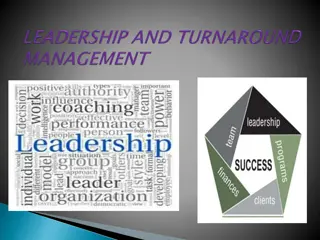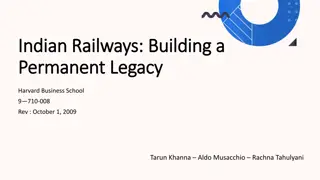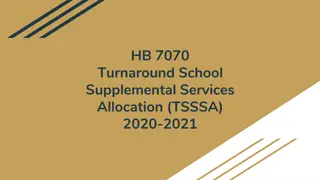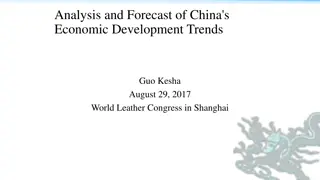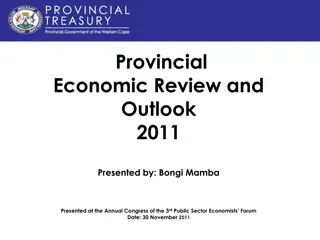Analysis of Indian Economic Growth: Perspectives and Turnaround
Dr. Shailesh Kumar, Assistant Professor at Bharati College, University of Delhi, delves into the Indian growth experience from two perspectives - aggregate growth over time and variations across states. The turnaround in growth measures post-1980, including GDP per capita and productivity, has been significant. Factors influencing this growth, such as increased productivity, stable growth rates post-1980, and improved performance compared to other countries, are explored.
Download Presentation

Please find below an Image/Link to download the presentation.
The content on the website is provided AS IS for your information and personal use only. It may not be sold, licensed, or shared on other websites without obtaining consent from the author. Download presentation by click this link. If you encounter any issues during the download, it is possible that the publisher has removed the file from their server.
E N D
Presentation Transcript
Dr Shailesh Kumar Assistant Professor Dept of Economics Bharati College University of Delhi
Growth Experience Analyse the Indian growth experience from two perspectives 1. India s aggregate growth experience over time why turned around? why the acceleration happen during 1980s? what was the explanation for that? 2. What are the reasons behind the variations in growth across Indian states?
Different measures of growth: GDP per capita Output per worker Total factor productivity There was a turned around in all measures of growth(GDP per capita, Output per worker & TFP) during 1980s.
1. Rate of growth of Indian economy in per capita terms since 1980 1950 t0 1980 ----------1.7% per annum 1980s omwards ------4% per annum This significant increase in per capita income marks a turnaround in the economy. This turn around was present in almost all measures of growth- e.g. output per capita, . output per worker and total factor productivity (TPF) as all of these accelerated sharply after 1980. The most striking feature was in TPF from 0.3%(1960-80) to 2%(1980- 2000) p.a. Growth accounting decomposition shows that contribution of growth of TPF to overall labour productivity growth was exceptionally high i.e.around 60% b/n 1980-2000 (a performance that was only surpassed by china). This implies that economic growth in India since 1980 is a result of increases in productivity and hence sustainable in future.
2. This turnaround has also been true at level of all three major sectors- Agriculture-- growth by 2.7% Manufacturing and services----growth from 2-3% to 6% 3. This surge in growth was also accompanied by reduction in instability of growth As Standard Deviation in the growth of output per worker Pre 1980-------3.7% Post 1980-------1.9% (a performance better than almost every other country Shows that in period after 1980 India has had a very high and very stable growth 4. The improvement in India s performance is also confirmed by the cross national evidence in form of barro type cross country growth regression for period 1960-80 and 1980-99 It suggests that after controlling policies, endowments and initial income India grew at-----0.7% p.a.(b/n 1960-80)---slower than the average country India grew at-----2.1% p.a.(b/n 1980-99)---faster than the average country It shows that India performed much better than other countries since 1980
II. Causes of reversal of fortune around 1980 Author argue that this is difficult to explain it through serious reforms i.e. External liberalization (as it happened at the end of 1990s) and internal reforms (that were implemented in labour and product market in 1980s and esp. de-licensing started in late 1980s but these were too little and too late to explain such a big turnaround). Ahluwalia, Srinivasan and Tendulkar (2002,2003) also felt that fiscal expansionism of 1980s accompanied by some liberalization of controls in 1980s brought a 5.9% pa growth but that growth was unsustainable and led to macro economic crisis of 1991 Author maintains that fiscal expansion led to increased fiscal deficit from 5% to 9% (b/n 1970-80) even if we apply its impact on demand side (Keynesian run amok explanation), increased demand cannot explain a large and sustained rise in trend productivity (supply side performance) Even if we assume that demand induced increase in productivity was the result of capacity utilization. Data shows that b/n 1970-80 capacity utilization increased by 2.7% , that can only explain 1% increase in TFP and around 2.2% of Increase in TFP remains unexplained
Alternative explanations-According to subramaniam alternative explanation comprises three elements- 1.Attitudinal change on the part of govt in 1980s,signalling a shift in attitude towards private sector accompanied by hap- hazard and gradual policy change e.g. national govt. led by Indira Gandhi became mildy supportive and eventually quite supportive towards private business. These attitudinal changes were aimed at gather political support from business establishments. Hence there were more actions were they were present rather than where they did not. 2. These policy changes were pro- business rather than pro-competition aimed at primarily benefitting already existing (established incumbents) industrial and commercial enterprises Pro-competition changes(reforms) focuses on removing impediments to markets and aims to achieve this through economic liberalization. It favours entrants and consumers. Pro-business changes(reforms) focuses on raising the profitability of the established industrial and commercial enterprises. It favours incumbents and producers. E.g. Reducing taxes, easing acCess to imported capital inputs or liberalising capacity restrictions
3. These small shifts elicited a large productivity response as India was far away from its income possibility frontier. III. State level growth According to Ahluwalia(2000) Prior to 1980s, growth rate of Indian states was mediocre and relatively uniform but after 1980 growth rate of states diverged considerably (means some states moved at much faster rates compared to other states) What explains these divergent pattern of growth across states in India 1. Different states had different pre-existing capabilities. but these remained hidden (could not find expression) until the economic environment changed. By pre-existing capabilities here author means states ability to diversify its manufacturing base. This diversified base can be best felt by the states capability of utilizing its human capital, entrepreneurial spirit and organisational capital in the presence of favourable environment
2. Liberalization of early 1980s and decentralization of economic power that was forced by changing political landscape after 1980s were the twin triggers of growth that explains how different states performed. Congress party for the first time lost political power in 1977, regain its position back in 1980s but many states were captured by the opposition. This kind of divergence of economic power led to divergence of economic policies and their impacts across states after 1980. Moreover, as private investors are more sensitive to differences in economic policies adopted by states, rising trend in private investment and falling trend in public investment also contributed to differentiation across states. Author shows that- it is evident that states economic performance was more closely tied to state level policies and institution in post 1980 period than before as an impact of decentralization of powers. Author shows it with an example of performance of electricity boards across states in terms of transmission and distribution losses. T and D losses refers to losses that accur due to natural loss in the process of distribution of electricity and losses due to stealing.
Where T and D losses (high)----------quality of power i.e. voltage and reliability (low) Shows that T and D losses are not directly related to capacity but are also determined by state level policy decisions. Lossess can be minimised by improving controls and creating institutions to inforce law and non-presence of these is a state failure. Author finds that the states with low T and D losses progressed at a faster rate b/n 1980-2000 Implications- Economic development results from the interaction of growth triggers with the right fundamentals that allow the triggers to be exploited. The fundamentals are not just the pooled of skilled human capital built through technology, management and research institutions. They go beyond and consist of meta institutions of democracy, rule of law, free press and technocratic bureaucracy, however what is most important is the quality of institutions
Scope of state activities are shrinking day by day whereas what is needed is an effective and competent state for performing some core functions. There is a clear cut institutional decline over the period of time that is needed to be reversed both at national and state level. Higher growth in india has led to higher inequalities across states i.e. more divergent growth. Challenge before India is to reverse the divergence of growth across states (to reduce economic Inequalities across states)- How the divergences or inequalities exists between different states of India can be reversed or reduced back is a big question. One suggestion or way out is making capital and labourers to move across or between states to cover-up or bridge up the gap exists. Because free flow of capital to a deficit state can fulfil the capital requirement for development but in reality capital will Never flow to underdeveloped regions or States where numerous problems exists such as law and order, poor policy implementation and poor
What happened then is the convergence or growth catching or matching between states in growth will fail and divergences or inequalities between states will be widened and large. Laboures from underdeveloped regions will migrate to developed regions in search of job. So, it will create another problem and challenge for policy makers. Skilling labourers through training program and improving governance and provisioning better infrastructure will address the growth inequalities between States. By creating the conditions for greater economic convergence across states and skill groups. State has a very important role to play in this governance. THANK YOU
















